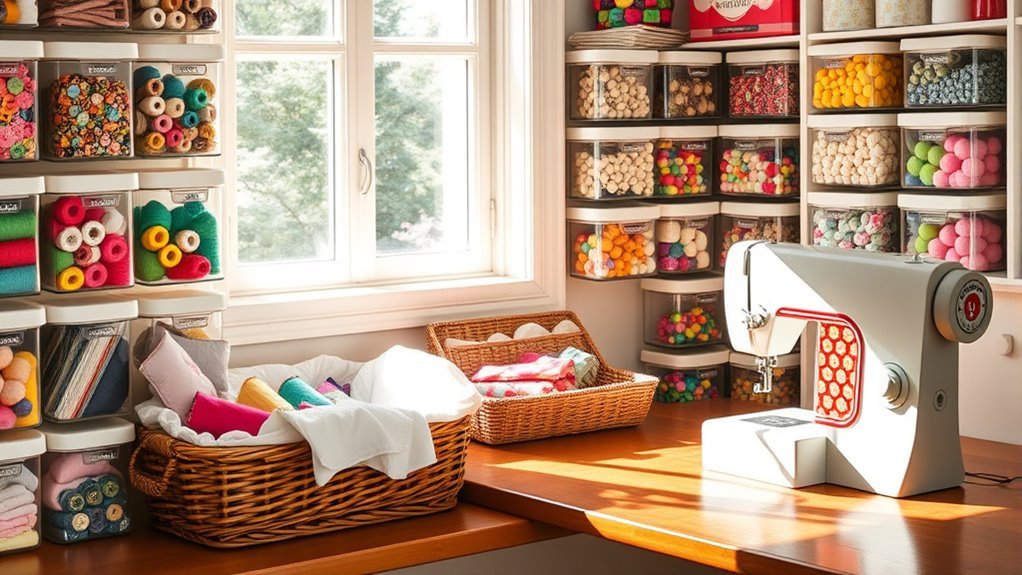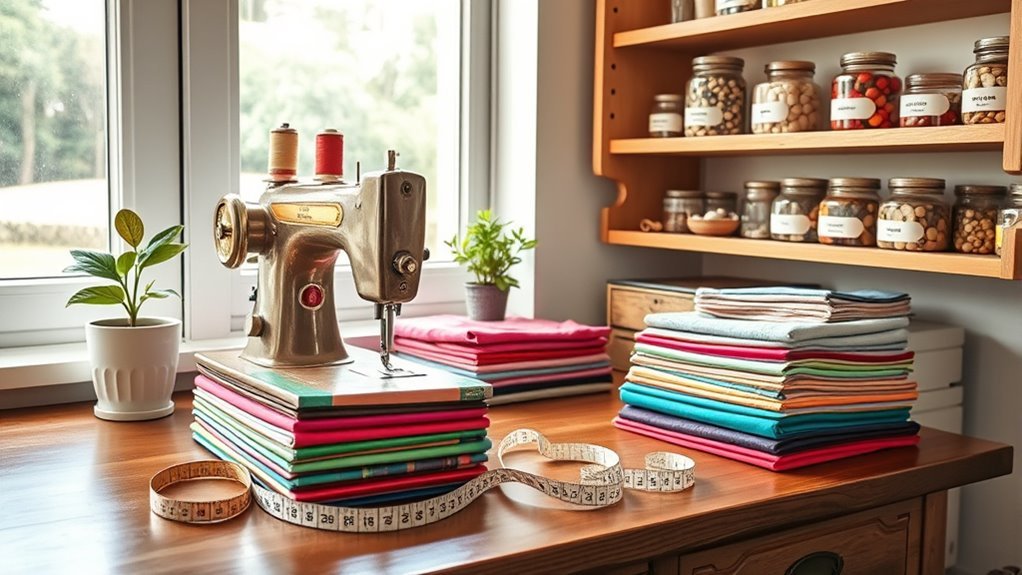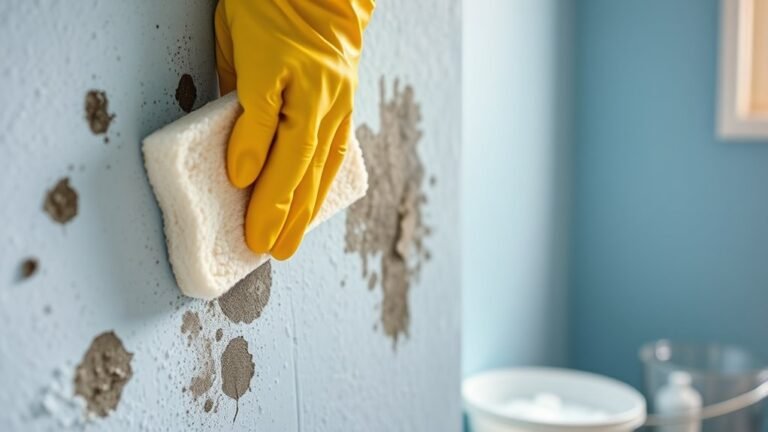Cleaning Tips for a Home Sewing Corner
To keep your home sewing corner clean and inspiring, start by decluttering regularly to create a focused workspace. Organize fabrics by type and color, and use clear containers for small supplies to find what you need quickly. Don’t forget to clean your sewing machine and tools often to guarantee smooth operation. Set aside time each week for a quick tidy-up to prevent clutter buildup. Stick with these habits, and you’ll discover even more ways to boost your creative flow.
Declutter Your Sewing Space Regularly

Although it might be tempting to leave your sewing supplies scattered, regularly decluttering your sewing space will make your work more efficient and enjoyable. When you keep your area tidy, you free yourself from the chaos that can slow down your creativity. Think of your sewing space as a project management zone; having clear surfaces and organized tools allows you to focus on what matters—your craft. By routinely sorting through your materials and removing what you don’t need, you create a sense of freedom that fuels productivity. This simple habit prevents overwhelm and helps you start each project with a fresh mindset. Embrace decluttering as a key step toward reclaiming control and enhancing your sewing experience.
Organize Fabrics by Type and Color
When you organize your fabrics by type and color, finding the material you need becomes much quicker and less frustrating. Start by grouping fabrics—cotton, silk, linen—so you can easily grab what suits your project. Use fabric folding techniques that keep your materials neat and visible, preventing wrinkles and saving space. Next, apply color coding to create a visual system: arrange fabrics from light to dark or by hues, making it effortless to spot the perfect shade. This method frees you from digging through piles, letting your creativity flow without interruption. By maintaining this order, your sewing corner feels open and inviting, giving you the freedom to focus on what matters—bringing your ideas to life with ease and joy.
Use Storage Containers for Small Supplies

Three key storage containers can transform how you manage small sewing supplies. First, clear plastic bins let you spot what you need instantly, freeing you from digging through clutter. Next, compartmentalized boxes are perfect for supply organization—thread spools, buttons, and needles stay separated, so you can grab exactly what you want without hassle. Finally, stackable drawers maximize your corner’s vertical space, keeping essentials within reach but out of sight. These storage solutions not only keep your sewing area tidy but also give you the freedom to focus on creativity, not chaos. By investing in smart containers, you make your sewing corner a place of inspiration and ease, where every small supply has its spot and your projects flow smoothly.
Clean Your Sewing Machine and Tools
Since your sewing machine and tools get constant use, keeping them clean is essential for smooth operation and longevity. Regular machine maintenance prevents buildup of lint and dust that can cause jams or uneven stitching. You don’t have to be a pro—just unplug your machine, remove the needle and bobbin, and use a soft brush to clear debris. Wipe down surfaces with a dry cloth to maintain tool hygiene, ensuring your scissors, pins, and measuring tape stay rust-free and ready to work. Clean tools not only perform better but also help you stay inspired and free to create without interruptions. Make cleaning a simple habit, and your sewing corner will stay efficient and inviting for all your creative projects.
Designate a Scrap Fabric Bin

Keeping your sewing machine and tools clean is just one step to maintaining an organized workspace. Another essential habit is to designate a scrap fabric bin. By having a specific place for your fabric leftovers, you’ll prevent clutter and make scrap usage easier and more intentional. This simple step encourages fabric recycling, letting you repurpose bits you might otherwise toss away. When those small pieces are neatly contained, it’s easier to grab them for patchwork, appliqués, or creative experiments, freeing you from waste and disorganization. Embracing this practice not only respects your materials but also fuels your creative freedom. So, set up a dedicated bin for scraps and enjoy a tidier, more efficient sewing corner where inspiration flows freely.
Maintain a Thread and Notions Organizer
A well-maintained thread and notions organizer makes your sewing sessions smoother and more enjoyable. Keep your thread storage neat by arranging spools by color or type, so you can quickly grab what you need without digging through a mess. Use clear containers or labeled compartments to separate your notion categories—buttons, needles, pins, and zippers—making everything easy to find at a glance. Regularly check for empty bobbins or broken tools and remove them, keeping your space functional and free. By staying organized, you’ll save time and feel more creative, giving you the freedom to focus on your projects without frustration. Maintaining order in your thread and notions organizer isn’t just tidying up—it’s creating a space where your ideas can flow effortlessly.
Schedule Weekly Tidying Sessions
Setting aside just 30 minutes each week to tidy your sewing corner can make a huge difference in maintaining an organized and efficient workspace. By scheduling weekly tidying sessions, you take control of your time management, preventing clutter from piling up and disrupting your creative flow. This simple cleaning routine helps you stay on top of supplies, clear your work surface, and quickly identify what needs replenishing. Treat these sessions as non-negotiable appointments with yourself—freedom comes from having a space that supports your creativity without distractions. When tidying becomes a habit, your sewing corner will consistently feel inviting and ready for your next project, making your creative process smoother and more enjoyable. Prioritize this weekly ritual to maintain focus and freedom in your crafting space.
Frequently Asked Questions
How Do I Prevent Dust Buildup on My Sewing Machine?
To prevent dust buildup on your sewing machine, you should use machine covers when it’s not in use. This simple step keeps dust out and protects your gear. Also, don’t skip regular maintenance—cleaning and oiling your machine guarantees it runs smoothly and lasts longer. Staying on top of these habits lets you enjoy your creative freedom without worrying about your machine getting clogged or damaged by dust.
What Is the Best Lighting for a Sewing Corner?
Imagine your sewing corner as a lighthouse guiding your creativity through foggy nights. You need task lighting that shines like a beacon, focused and bright, to help you see every stitch clearly. But don’t forget natural light—it’s your soul’s sunlight, invigorating and inspiring. Combine both, and you’ll create a free, open space where your ideas flow effortlessly, unhindered by shadows or strain, letting your imagination truly soar.
How Can I Reduce Noise From My Sewing Machine?
To reduce noise from your sewing machine, you can try some effective noise reduction strategies. Start by placing your machine on a thick mat or foam pad to absorb vibrations. You might also explore soundproofing techniques like adding acoustic panels or heavy curtains around your sewing area. These simple changes let you enjoy your creativity freely without distractions, giving you the peaceful, focused environment you deserve while working on your projects.
Are There Eco-Friendly Cleaning Products for Sewing Supplies?
Did you know 60% of consumers now prefer eco-friendly products? You’ll love switching to biodegradable cleaners for your sewing supplies—they’re tough on grime but gentle on the planet. Natural disinfectants like vinegar or tea tree oil keep your tools germ-free without harsh chemicals. Embracing these options lets you maintain your creative freedom while caring for the Earth, making your sewing space both clean and consciously curated.
How Do I Store Delicate Vintage Fabrics Safely?
When storing delicate vintage fabrics, you’ll want to focus on fabric preservation to keep them safe and vibrant. Avoid plastic bags—they trap moisture. Instead, choose acid-free tissue paper and breathable storage solutions like cotton bags or boxes. Keep them in a cool, dry place away from direct sunlight to prevent fading. By giving your fabrics proper care, you’re preserving their beauty and history, letting you enjoy your creative freedom without worry.






